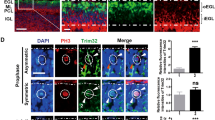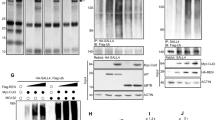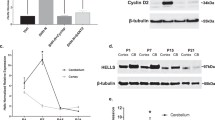Abstract
High-level amplification of the protein phosphatase PPM1D (WIP1) is present in a subset of medulloblastomas (MBs) that have an expression profile consistent with active Sonic Hedgehog (SHH) signaling. We found that WIP1 overexpression increased expression of Shh target genes and cell proliferation in response to Shh stimulation in NIH3T3 and cerebellar granule neuron precursor cells in a p53-independent manner. Thus, we developed a mouse in which WIP1 is expressed in the developing brain under control of the Neurod2 promoter (ND2:WIP1). The external granule layer (EGL) in early postnatal ND2:WIP1 mice exhibited increased proliferation and expression of Shh downstream targets. MB incidence increased and survival decreased when ND2:WIP1 mice were crossed with an Shh-activated MB mouse model. Conversely, Wip1 knockout significantly suppressed MB formation in two independent mouse models of Shh-activated MB. Furthermore, Wip1 knockdown or treatment with a WIP1 inhibitor suppressed the effects of Shh stimulation and potentiated the growth inhibitory effects of SHH pathway-inhibiting drugs in Shh-activated MB cells in vitro. This suggests an important cross-talk between SHH and WIP1 pathways that accelerates tumorigenesis and supports WIP1 inhibition as a potential treatment strategy for MB.
This is a preview of subscription content, access via your institution
Access options
Subscribe to this journal
Receive 50 print issues and online access
$259.00 per year
only $5.18 per issue
Buy this article
- Purchase on Springer Link
- Instant access to full article PDF
Prices may be subject to local taxes which are calculated during checkout








Similar content being viewed by others
References
von Hoff K, Hinkes B, Gerber NU, Deinlein F, Mittler U, Urban C et al. Long-term outcome and clinical prognostic factors in children with medulloblastoma treated in the prospective randomised multicentre trial HIT'91. Eur J Cancer 2009; 45: 1209–1217.
Torres CF, Rebsamen S, Silber JH, Sutton LN, Bilaniuk LT, Zimmerman RA et al. Surveillance scanning of children with medulloblastoma. N Engl J Med 1994; 330: 892–895.
Northcott PA, Korshunov A, Witt H, Hielscher T, Eberhart CG, Mack S et al. Medulloblastoma comprises four distinct molecular variants. J Clin Oncol 2011; 29: 1408–1414.
Samkari A, White J, Packer R . SHH inhibitors for the treatment of medulloblastoma. Expert Rev Neurother 2015; 15: 1–8.
Ellison D . Classifying the medulloblastoma: insights from morphology and molecular genetics. Neuropathol Appl Neurobiol 2002; 28: 257–282.
Burnett ME, White EC, Sih S, von Haken MS, Cogen PH . Chromosome arm 17p deletion analysis reveals molecular genetic heterogeneity in supratentorial and infratentorial primitive neuroectodermal tumors of the central nervous system. Cancer Genet Cytogenet 1997; 97: 25–31.
Tabori U, Baskin B, Shago M, Alon N, Taylor MD, Ray PN et al. Universal poor survival in children with medulloblastoma harboring somatic TP53 mutations. J Clin Oncol 2010; 28: 1345–1350.
Frank AJ, Hernan R, Hollander A, Lindsey JC, Fuller CE et al. Lusher ME The TP53-ARF tumor suppressor pathway is frequently disrupted in large/cell anaplastic medulloblastoma. Brain Res Mol Brain Res 2004; 121: 137–140.
Northcott PA, Shih DJ, Peacock J, Garzia L, Morrissy AS, Zichner T et al. Subgroup-specific structural variation across 1,000 medulloblastoma genomes. Nature 2012; 488: 49–56.
Oliver TG, Read TA, Kessler JD, Mehmeti A, Wells JF, Huynh TT et al. Loss of patched and disruption of granule cell development in a pre-neoplastic stage of medulloblastoma. Development 2005; 132: 2425–2439.
Schuller U, Heine VM, Mao J, Kho AT, Dillon AK, Han YG et al. Acquisition of granule neuron precursor identity is a critical determinant of progenitor cell competence to form Shh-induced medulloblastoma. Cancer Cell 2008; 14: 123–134.
Marino S, Vooijs M, van der Gulden H, Jonkers J, Berns A . Induction of medulloblastomas in p53-null mutant mice by somatic inactivation of Rb in the external granular layer cells of the cerebellum. Genes Dev 2000; 14: 994–1004.
Wechsler-Reya RJ, Scott MP . Control of neuronal precursor proliferation in the cerebellum by Sonic Hedgehog. Neuron 1999; 22: 103–114.
Doucette TA, Yang Y, Pedone C, Kim JY, Dubuc A, Northcott PD et al. WIP1 enhances tumor formation in a sonic hedgehog-dependent model of medulloblastoma. Neurosurgery 2012; 70: 1003–1010; discussion 1010.
Pandolfi S, Montagnani V, Penachioni JY, Vinci MC, Olivito B, Borgognoni L et al. WIP1 phosphatase modulates the Hedgehog signaling by enhancing GLI1 function. Oncogene 2012; 32: 4737–4747.
Hyman JM, Firestone AJ, Heine VM, Zhao Y, Ocasio CA, Han K et al. Small-molecule inhibitors reveal multiple strategies for Hedgehog pathway blockade. Proc Natl Acad Sci USA 2009; 106: 14132–14137.
Chen JK, Taipale J, Young KE, Maiti T, Beachy PA . Small molecule modulation of smoothened activity. Proc Natl Acad Sci USA 2002; 99: 14071–14076.
Vassilev LT, Vu BT, Graves B, Carvajal D, Podlaski F, Filipovic Z et al. In vivo activation of the p53 pathway by small-molecule antagonists of MDM2. Science 2004; 303: 844–848.
Hallahan AR, Pritchard JI, Hansen S, Benson M, Stoeck J, Hatton BA et al. The SmoA1 mouse model reveals that notch signaling is critical for the growth and survival of sonic hedgehog-induced medulloblastomas. Cancer Res 2004; 64: 7794–7800.
Bhatia B, Malik A, Fernandez LA, Kenney AM . p27(Kip1), a double-edged sword in Shh-mediated medulloblastoma: tumor accelerator and suppressor. Cell Cycle 2010; 9: 4307–4314.
Demidov ON, Kek C, Shreeram S, Timofeev O, Fornace AJ, Appella E et al. The role of the MKK6/p38 MAPK pathway in Wip1-dependent regulation of ErbB2-driven mammary gland tumorigenesis. Oncogene 2007; 26: 2502–2506.
Nannenga B, Lu X, Dumble M, Van Maanen M, Nguyen TA, Sutton R et al. Augmented cancer resistance and DNA damage response phenotypes in PPM1D null mice. Mol Carcinog 2006; 45: 594–604.
Bulavin DV, Phillips C, Nannenga B, Timofeev O, Donehower LA, Anderson CW et al. Inactivation of the Wip1 phosphatase inhibits mammary tumorigenesis through p38 MAPK-mediated activation of the p16(Ink4a)-p19(Arf) pathway. Nat Genet 2004; 36: 343–350.
Rodon J, Tawbi HA, Thomas AL, Stoller RG, Turtschi CP, Baselga J et al. A phase I, multicenter, open-label, first-in-human, dose-escalation study of the oral smoothened inhibitor Sonidegib (LDE225) in patients with advanced solid tumors. Clin Cancer Res 2014; 20: 1900–1909.
Emelyanov A, Bulavin DV . Wip1 phosphatase in breast cancer. Oncogene 2014; 34: 4429–4438.
Bulavin DV, Demidov ON, Saito S, Kauraniemi P, Phillips C, Amundson SA et al. Amplification of PPM1D in human tumors abrogates p53 tumor-suppressor activity. Nat Genet 2002; 31: 210–215.
Saito-Ohara F, Imoto I, Inoue J, Hosoi H, Nakagawara A, Sugimoto T et al. PPM1D is a potential target for 17q gain in neuroblastoma. Cancer Res 2003; 63: 1876–1883.
Castellino RC, De Bortoli M, Lu X, Moon SH, Nguyen TA, Shepard MA et al. Medulloblastomas overexpress the p53-inactivating oncogene WIP1/PPM1D. J Neurooncol 2008; 86: 245–256.
Buss MC, Read TA, Schniederjan MJ, Gandhi K, Castellino RC . HDM2 promotes WIP1-mediated medulloblastoma growth. Neuro Oncol 2012; 14: 440–458.
Ellison DW, Dalton J, Kocak M, Nicholson SL, Fraga C, Neale G et al. Medulloblastoma: clinicopathological correlates of SHH, WNT, and non-SHH/WNT molecular subgroups. Acta Neuropathol 2011; 121: 381–396.
Buss MC, Remke M, Lee J, Gandhi K, Schniederjan MJ, Kool M et al. The WIP1 oncogene promotes progression and invasion of aggressive medulloblastoma variants. Oncogene 2015; 34: 1126–1140.
Lu X, Nguyen TA, Zhang X, Donehower LA . The Wip1 phosphatase and Mdm2: cracking the "Wip" on p53 stability. Cell Cycle 2008; 7: 164–168.
Stecca B, Ruiz i Altaba A . A GLI1-p53 inhibitory loop controls neural stem cell and tumour cell numbers. EMBO J 2009; 28: 663–676.
Abe Y, Oda-Sato E, Tobiume K, Kawauchi K, Taya Y, Okamoto K et al. Hedgehog signaling overrides p53-mediated tumor suppression by activating Mdm2. Proc Natl Acad Sci USA 2008; 105: 4838–4843.
Rayter S, Elliott R, Travers J, Rowlands MG, Richardson TB, Boxall K et al. A chemical inhibitor of PPM1D that selectively kills cells overexpressing PPM1D. Oncogene 2008; 27: 1036–1044.
Gilmartin AG, Faitg TH, Richter M, Groy A, Seefeld MA, Darcy MG et al. Allosteric Wip1 phosphatase inhibition through flap-subdomain interaction. Nat Chem Biol 2014; 10: 181–187.
Yoda A, Toyoshima K, Watanabe Y, Onishi N, Hazaka Y, Tsukuda Y et al. Arsenic trioxide augments Chk2/p53-mediated apoptosis by inhibiting oncogenic Wip1 phosphatase. J Biol Chem 2008; 283: 18969–18979.
Parathath SR, Mainwaring LA, Fernandez LA, Campbell DO, Kenney AM . Insulin receptor substrate 1 is an effector of sonic hedgehog mitogenic signaling in cerebellar neural precursors. Development 2008; 135: 3291–3300.
Castellino RC, De Bortoli M, Lin LL, Skapura DG, Rajan JA, Adesina AM et al. Overexpressed TP73 induces apoptosis in medulloblastoma. BMC Cancer 2007; 7: 127.
Lamprecht MR, Sabatini DM, Carpenter AE . CellProfiler: free, versatile software for automated biological image analysis. Biotechniques 2007; 42: 71–75.
Choi J, Nannenga B, Demidov ON, Bulavin DV, Cooney A, Brayton C et al. Mice deficient for the wild-type p53-induced phosphatase gene (Wip1) exhibit defects in reproductive organs, immune function, and cell cycle control. Mol Cell Biol 2002; 22: 1094–1105.
Yang ZJ, Ellis T, Markant SL, Read TA, Kessler JD, Bourboulas M et al. Medulloblastoma can be initiated by deletion of Patched in lineage-restricted progenitors or stem cells. Cancer Cell 2008; 14: 135–145.
Kenney AM, Cole MD, Rowitch DH . Nmyc upregulation by sonic hedgehog signaling promotes proliferation in developing cerebellar granule neuron precursors. Development 2003; 130: 15–28.
Suresh K . An overview of randomization techniques: an unbiased assessment of outcome in clinical research. J Hum Reprod Sci 2011; 4: 8–11.
Hatton BA, Villavicencio EH, Tsuchiya KD, Pritchard JI, Ditzler S, Pullar B et al. The Smo/Smo model: hedgehog-induced medulloblastoma with 90% incidence and leptomeningeal spread. Cancer Res 2008; 68: 1768–1776.
Vanner RJ, Remke M, Gallo M, Selvadurai HJ, Coutinho F, Lee L et al. Quiescent sox2(+) cells drive hierarchical growth and relapse in sonic hedgehog subgroup medulloblastoma. Cancer Cell 2014; 26: 33–47.
Acknowledgements
We acknowledge Drs James Olson and Xiongbin Lu for providing mice and expression constructs, and Dr Oskar Laur in the Emory University CCCF for plasmid construction. This work was supported by the NIH (1R01CA172392, RCC; CA159859, MDT), St Baldrick’s Foundation (RCC), CURE Childhood Cancer Foundation (RCC) and the Dr Mildred-Scheel Foundation (MR).
Author information
Authors and Affiliations
Corresponding author
Ethics declarations
Competing interests
The authors declare no conflict of interest.
Additional information
Supplementary Information accompanies this paper on the Oncogene website
Supplementary information
Rights and permissions
About this article
Cite this article
Wen, J., Lee, J., Malhotra, A. et al. WIP1 modulates responsiveness to Sonic Hedgehog signaling in neuronal precursor cells and medulloblastoma. Oncogene 35, 5552–5564 (2016). https://doi.org/10.1038/onc.2016.96
Received:
Revised:
Accepted:
Published:
Issue Date:
DOI: https://doi.org/10.1038/onc.2016.96
This article is cited by
-
Targeting cancer stem cell pathways for cancer therapy
Signal Transduction and Targeted Therapy (2020)
-
Medulloblastoma, WNT-activated/SHH-activated: clinical impact of molecular analysis and histogenetic evaluation
Child's Nervous System (2018)



